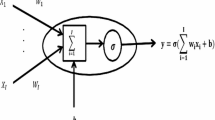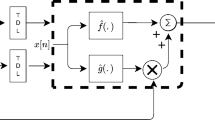Abstract
In this paper, a class of infinite-horizon nonlinear optimal control problems is considered. The main idea is to convert the infinite horizon problem to an equivalent finite-horizon optimal control problem. According to the Pontryagin minimum principle for optimal control problems and by constructing an error function, we define an unconstrained minimization problem. In the optimization problem, we use trial solutions for the state, costate and control functions where these trial solutions are constructed by using two-layer perceptron. We then minimize the error function where weights and biases associated with all neurons are unknown. Substituting the optimal values of the weights and biases into the trial solutions, we obtain the optimal solution of the original problem. We also use a dynamic optimization scheme to learning process and discuss the stability and convergence properties of it. Some examples are given to show the efficiency of the method.








Similar content being viewed by others
References
Blot J (2009) Infinite-horizon Pontryagin principles without invertibility. J Nonlinear Convex Anal 10:177–189
Blot J, Cartigny P (2000) Optimality in infinite-horizon variational problems under sign conditions. J Optim Theory Appl 106:411–419
Effati S, Nazemi AR (2007) A new approach for asymptotic stability of the nonlinear ordinary differential equations. J Appl Math Comput 25:231–244
Garg D, Hager WW, Rao AV (2011) Pseudospectral methods for solving infinite-horizon optimal control problems. Automatica 47:829–837
Effati S, Kamyad AV, Kamyabi- Gol RA (2000) On infinite-horizon optimal control problems. Z Anal Anwend 19:269–278
Jasso-Fuentes H, Hernandez-Lerma O (2008) Characterizations of overtaking optimality for controlled diffusion processes. Appl Math Optim 57:349–369
Leizarowitz A (1985) Infinite horizon autonomous systems with unbounded cost. Appl Math Optim 13:19–43
Mordukhovich B (1990) Minimax design for a class of distributed parameter systems. Autom Remote Control 50:1333–1340
Mordukhovich B, Shvartsman I (2004) Optimization and feedback control of constrained parabolic systems under uncertain perturbations. In: de Queiroz MS, Malisoff M, Wolenski P (eds) Optimal control, stabilization and nonsmooth analysis. Lecture notes in control and information sciences. Springer, Berlin, pp 121–132
Pickenhain S, Lykina V (2006) Sufficiency conditions for infinite horizon optimal control problems. In: Seeger A (ed) Recent advances in optimization. Proceedings of the 12th French-German-Spanish conference on optimization, Avignon. Springer, Berlin, pp 217–232
Pickenhain S, Lykina V, Wagner M (2008) On the lower semicontinuity of functionals involving Lebesgue or improper Riemann integrals in infinite horizon optimal control problems. Control Cybern 37:451–468
Rapaport A, Cartigny P (2004) Turnpike theorems by a value function approach. ESAIM Control Optim Calc Var 10:123–141
Rapaport A, Cartigny P (2007) Nonturnpike optimal solutions and their approximations in infinite horizon. J Optim Theory Appl 134:1–14
Zaslavski AJ (2006) Turnpike properties in the calculus of variations and optimal control. Springer, New York
Anderson BDO, Moore JB (1971) Linear optimal control. Prentice-Hall, Englewood Cliffs
Leizarowitz A (1986) Tracking nonperiodic trajectories with the overtaking criterion. Appl Math Optim 14:155–171
Gale D (1967) On optimal development in a multi-sector economy. Rev Econ Stud 34:1–18
Makarov VL, Rubinov AM (1977) Mathematical theory of economic dynamics and equilibria. Springer, Berlin
Zaslavski AJ (2007) Turnpike results for a discrete-time optimal control system arising in economic dynamics. Nonlinear Anal 67:2024–2049
Zaslavski AJ (2009) Two turnpike results for a discrete-time optimal control systems. Nonlinear Anal 71:902–909
Aubry S, Le Daeron PY (1983) The discrete Frenkel–Kontorova model and its extensions: I. Exact results for the ground-states. Physica D 8:381–422
Zaslavski AJ (1987) Ground states in Frenkel–Kontorova model. Math USSR Izv 29:323–354
Coleman BD, Marcus M, Mizel VJ (1992) On the thermodynamics of periodic phases. Arch Ration Mech Anal 117:321–347
Leizarowitz A, Mizel VJ (1989) One dimensional infinite horizon variational problems arising in continuum mechanics. Arch Ration Mech Anal 106:161–194
Marcus M, Zaslavski AJ (1999) The structure of extremals of a class of second order variational problems. Ann Inst Henri Poincaré Anal Non Linéaire 16:593–629
Blot J, Michel P (1996) First-order necessary conditions for infinite-horizon variational problems. J Optim Theory Appl 88:339–364
Pontryagin LS, Boltyanski VS, Gamkrelidze RV, Mischenko EF (1962) The mathematical theory of optimal processes. Wiley, New York
Carlson DA, Haurie A (1987) Infinite-horizon optimal control. Lecture notes in economics and mathematical systems, vol 290. Springer, Germany
Smirnov GV (1996) Transversality condition for infinite-horizon problems. J Optim Theory Appl 88:671–688
Aubin JP, Clarke FH (1976) Shadow prices and duality for a class of optimal control problems. SIAM J Control Optim 17:567–587
Michel P (1992) On the transversality condition in infinite-horizon optimal problems. Econometrica 50:976–985
Ye JJ (1993) Non-smooth maximum principle for infinite-horizon problems. J Optim Theory Appl 76:485–500
Ekeland I (1988) some variational problems arising from mathematical economic. Lect Notes Math 1330:1–18
Nazemi AR, Mahmoudy N (2014) Solving infinite horizon optimal control problems using the Haar wavelet collocation method. ANZIAM J 56:179–191
Fahroo F, Ross IM (2008) Pseudospectral methods for infinite-horizon optimal control problems. J Guid Control Dyn 31:927–936
Schalkoff RJ (1997) Artificial neural networks. McGraw-Hill, New York
Minsky M, Papert S (1969) Perceptrons. MIT Press, Cambridge
Khanna T (1990) Foundations of neural networks. Addison-Wesley, Reading
Stanley J (1990) Introduction to neural networks, 3rd edn. Sierra Mardre Press, Sierra Madre
Lippmann RP (1987) An introduction to computing with neural nets. IEEE ASSP Mag 4:4–22
Hornick K, Stinchcombe M, White H (1989) Multilayer feedforward networks are universal approximators. Neural Netw 2(5):359–366
Lapedes A, Farber R (1988) How neural nets work? In: Anderson DZ (ed) Neural information processing systems, AIP. Springer, New York, pp 442–456
Mckeown JJ, Stella F, Hall G (1997) Some numerical aspects of the training problem for feed-forward neural nets. Neural Netw 10(8):1455–1463
Haykin S (2007) Neural networks: a comprehensive foundation, 3rd edn. Prentice-Hall, Upper Saddle River
Graupe D (2007) Principles of artificial neural networks, 2nd edn. World Scientific, Singapore
Tang H, Tan KC, Yi Z (2007) Neural networks: computational models and applications. Springer, Berlin
Muller B, Reinhardt J, Strickland MT (2002) Neural networks: an introduction, 2nd edn. Springer, Berlin
Picton P (2000) Neural networks, 2nd edn. Palgrave, Great Britain
Fine TL (1999) Feed forward neural network methodology. Springer, New York
Ellacott SW (1997) Mathematics of neural networks: models, algorithms and applications. Kluwer Academic Publishers, Boston
Lagaris IE, Likas A, Fotiadis DI (1998) Artificial neural networks for solving ordinary and partial differential equations. IEEE Trans Neural Netw 9:987–1000
Malek A, Shekari Beidokhti R (2006) Numerical solution for high order differential equations using a hybrid neural network. Optim Method Appl Math Comput 183:260–271
Shekari Beidokhti R, Malek A (2009) Solving initial-boundary value problems for systems of partial differential equations using neural networks and optimization techniques. J Frankl Inst 346:898–913
Tsoulos IG, Gavrilis D, Glavas E (2009) Solving differential equations with constructed neural networks. Neurocomputing 72:2385–2391
Kumar M, Yadav N (2011) Multilayer perceptrons and radial basis function neural network methods for the solution of differential equations: a survey. Comput Math Appl 62:3796–3811
Dua V (2011) An artificial neural network approximation based decomposition approach for parameter estimation of system of ordinary differential equations. Comput Chem Eng 35:545–553
Shirvany Y, Hayati M, Moradian R (2008) Numerical solution of the nonlinear Schrodinger equation by feedforward neural networks. Commun Nonlinear Sci Numer Simul 13:2132–2145
Shirvany Y, Hayati M, Moradian R (2009) Multilayer perceptron neural networks with novel unsupervised training method for numerical solution of the partial differential equations. Appl Soft Comput 9:20–29
Balasubramaniam P, Kumaresan N (2008) Solution of generalized matrix Riccati differential equation for indefinite stochastic linear quadratic singular system using neural networks. Appl Math Comput 204:671–679
Becerikli Y, Konarm AF, Samad T (2003) Intelligent optimal control with dynamic neural networks. Neural Netw 16:251–259
Vrabie D, Lewis F (2009) Neural network approach to continuous-time direct adaptive optimal control for partially unknown nonlinear systems. Neural Netw 22:237–246
Vrabie D, Lewis F, Levine D (2008) Neural network-based adaptive optimal controller—a continuous-time formulation. Commun Comput Inf Sci 15:276–285
Cheng T, Lewis FL, Abu-Khalaf M (2007) Fixed-final-time-constrained optimal control of nonlinear systems using neural network HJB approach. IEEE Trans Neural Netw 18:1725–1737
Effati S, Pakdaman M (2013) Optimal control problem via neural networks. Neural Comput Appl 23:2093–2100
Nazemi AR (2011) A dynamical model for solving degenerate quadratic minimax problems with constraints. J Comput Appl Math 236:1282–1295
Nazemi AR (2012) A dynamic system model for solving convex nonlinear optimization problems. Commun Nonlinear Sci Numer Simul 17:1696–1705
Nazemi AR (2013) Solving general convex nonlinear optimization problems by an efficient neurodynamic model. Eng Appl Artif Intell 26:685–696
Nazemi AR, Omidi F (2012) A capable neural network model for solving the maximum flow problem. J Comput Appl Math 236:3498–3513
Nazemi AR (2014) A neural network model for solving convex quadratic programming problems with some applications. Eng Appl Artif Intell 32:54–62
Nazemi AR, Omidi F (2013) An efficient dynamic model for solving the shortest path problem. Transp Res C 26:1–19
Nazemi AR, Sharifi E (2013) Solving a class of geometric programming problems by an efficient dynamic model. Commun Nonlinear Sci Numer Simul 18:692–709
Nazemi AR, Effati S (2013) An application of a merit function for solving convex programming problems. Comput Ind Eng 66:212–221
Nazemi AR, Nazemi M (2014) A gradient-based neural network method for solving strictly convex quadratic programming problems. Cogn Comput 6:484–495
Bohner M, Kenzhebaev K, Lavrova O, Stanzhytskyi O (2017) Pontryagin’s maximum principle for dynamic systems on time scales. J Differ Equ Appl 23:1161–1189
Ferreira MMA, Ribeiro AF, Smirnov GV (2015) Local minima of quadratic functionals and control of hydro-electric power stations. JOTA J Optim Theory Appl 165:985–1005
Hartl RF, Sethi SP, Vickson RG (1995) A survey of the maximum pipnciples for optimal control problems with state constraints. SIAM Rev 37:181–218
Cybenko G (1989) Approximation by superpositions of a sigmoidal function. Math Control Signals Syst 2:303–314
Bazaraa MS, Sherali HD, Shetty CM (2006) Nonlinear programming—theory and algorithms, 3rd edn. Wiley, Hoboken
Zhang X-S (2000) Neural networks in optimization. Kluwer Academic Publishers, Dordrecht
Nocedal J, Wright S (2006) Numerical optimization, 2nd edn. Springer, Berlin
Lee KY, El-Sharkawi M (2007) A modern heuristic optimization techniques: theory and applications to power systems. Wiley, New York
Miller RK, Michel AN (1982) Ordinary differential equations. Academic Press, New York
Sun J, Chen J-S, Ko C-H (2012) Neural networks for solving second-order cone constrained variational inequality problem. Comput Optim Appl 51:623–648
Hale JK (1969) Ordinary differential equations. Wiley, New York
Jajarmi A, Pariz N, Effati S, Kamyad AV (2011) Solving infinite horizon nonlinear optimal control problems using an extended modal series method. J Zhejiang Univ Sci C (Comput Electron) 12:667–677
Funding
This study was not funded by any grant.
Author information
Authors and Affiliations
Corresponding author
Ethics declarations
Conflict of interest
The authors declare that they have no conflict of interest.
Additional information
Publisher's Note
Springer Nature remains neutral with regard to jurisdictional claims in published maps and institutional affiliations.
Rights and permissions
About this article
Cite this article
Mortezaee, M., Nazemi, A. On Infinite Horizon Optimal Control Problems with a Feed Forward Neural Network Scheme. Neural Process Lett 51, 449–471 (2020). https://doi.org/10.1007/s11063-019-10099-5
Published:
Issue Date:
DOI: https://doi.org/10.1007/s11063-019-10099-5




